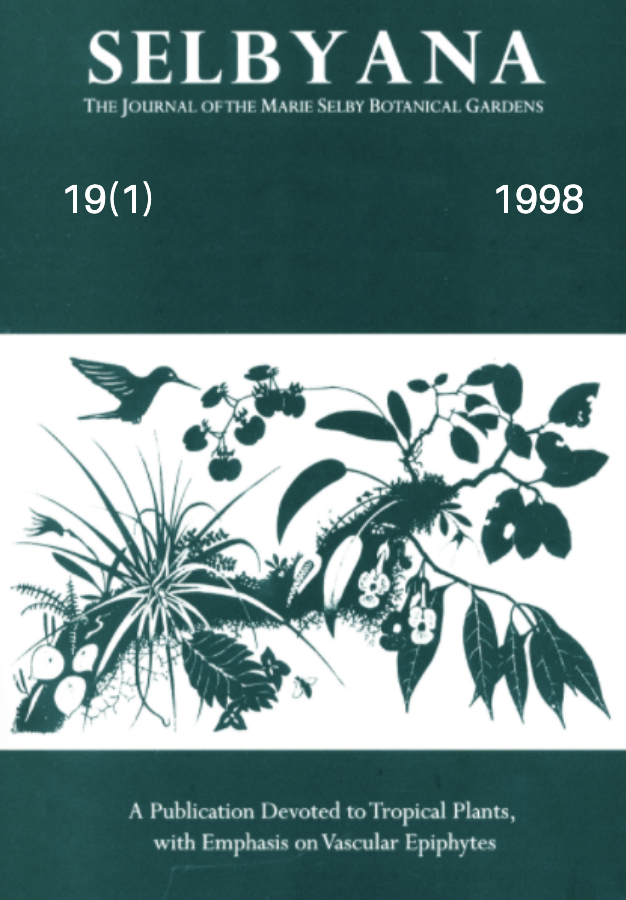Abstract
La fenología de la floración y fructificación de Tillandsia complanata Bentham y T. turneri Baker fue estudiada en un bosque montano alto de la Cordillera Oriental Colombiana. Se realizaron censos quincenales de 200 individuos (50 epífitos y 50 terrestres por especie) entre febrero de 1994 y enero de 1995. Se ubicaron pluviómetros al lado de 20 individuos epífitos de cada especie para medir la precipitación que llegaba a cada roseta a diferentes alturas dentro del dosel. La población de T. complanata floreció durante 9 meses y no hubo diferencias significativas entre la fenología de plantas epífitas o terrestres. Por el contrario, la población de T. turneri floreció durante dos periodos de 3 meses cada uno. El número de plantas epífitas que floreció durante el período de estudio (n = 19) fue significativamente mayor que el número de plantas terrestres (n = 8). Estos resultados sugieren que el hábito terrestre es desventajoso para la reproducción de individuos de T. turneri terrestres, que usualmente son producto de la caída de individuos epífitos. Las dos especies de Bromeliaceae estudiadas abrieron sus cápsulas en el mes más seco, facilitando la dispersión de las semillas. Los individuos de T. complanata ubicados a mayor altura dentro del dosel recibieron más agua y fueron más productivos que las bromelias ubicadas a menor altura. Las dos especies de bromelias presentan síndromes de ornitofilia y probablemente son polinizadas por Eriocnemis mosquera, la única especie de colibrí que se observó en el sitio de estudio. El hábito terrestre de T. turneri es desventajoso para la reproducción de las rosetas que parecen ser el producto de la caida de individuos epífitos. The flowering and fruiting phenology of Tillandsia complanata Bentham and T turneri Baker was studied in a montane cloud forest in the Eastern Andes of Colombia. Censuses of 200 individuals (50 epiphytes and 50 terrestrials per species) were carried out every two weeks between February 1994 and January 1995. Homemade rain gauges were placed beside 20 epiphytic rosettes of each species to measure the rain water reaching rosettes at different heights in the canopy. The population of T. complanata flowered for 9 consecutive months and there were no significant differences between the phenology of epiphytic and terrestrial plants. In contrast, the population of Ô turneri flowered during two 3-month periods. The number of epiphytic plants of T. turneri that flowered during the study (n = 19) was significantly higher than the number of terrestrial plants (n = 8). These results suggest that the terrestrial habit, which usually is the result of fallen epiphytes, is detrimental to the reproduction in T. turneri. The two bromeliad species opened their capsules during the driest month, facilitating seed dispersal. The rosettes located higher in the canopy received more rain and were more productive than the rosettes at lower heights. The two bromeliad species present ornithophyllic syndromes and are probably pollinated by Eriocnemis mosquera, the only hummingbird species seen in the study site. The terrestrial habit of T. turneri is detrimental to reproduction, and these rosettes seem to be the result of the fall of epiphytic individuals.
Open Access and Copyright Notice
Selbyana is committed to real and immediate open access for academic work. All of Selbyana's articles and reviews are free to access immediately upon publication. There are no author charges (APCs) prior to publication, and no charges for readers to download articles and reviews for their own scholarly use. To facilitate this, Selbyana depends on the financial backing of the Marie Selby Botanical Gardens, the hard work and dedication of its editorial team and advisory board, and the continuing support of its network of peer reviewers and partner institutions.
Authors are free to choose which open license they would like to use for their work. Our default license is the Creative Commons Attribution-NonCommercial 4.0 (CC BY-NC 4.0). While Selbyana’s articles can be copied by anyone for noncommercial purposes if proper credit is given, all materials are published under an open-access license with authors retaining full and permanent ownership of their work. The author grants Selbyana a perpetual, non-exclusive right to publish the work and to include it in other aggregations and indexes to achieve broader impact and visibility.
Authors are responsible for and required to ascertain that they are in possession of image rights for any and all photographs, illustrations, and figures included in their work or to obtain publication or reproduction rights from the rights holders. Contents of the journal will be registered with the Directory of Open Access Journals and similar repositories. Authors are encouraged to store their work elsewhere, for instance in institutional repositories or personal websites, including commercial sites such as academia.edu, to increase circulation (see The Effects of Open Access).
